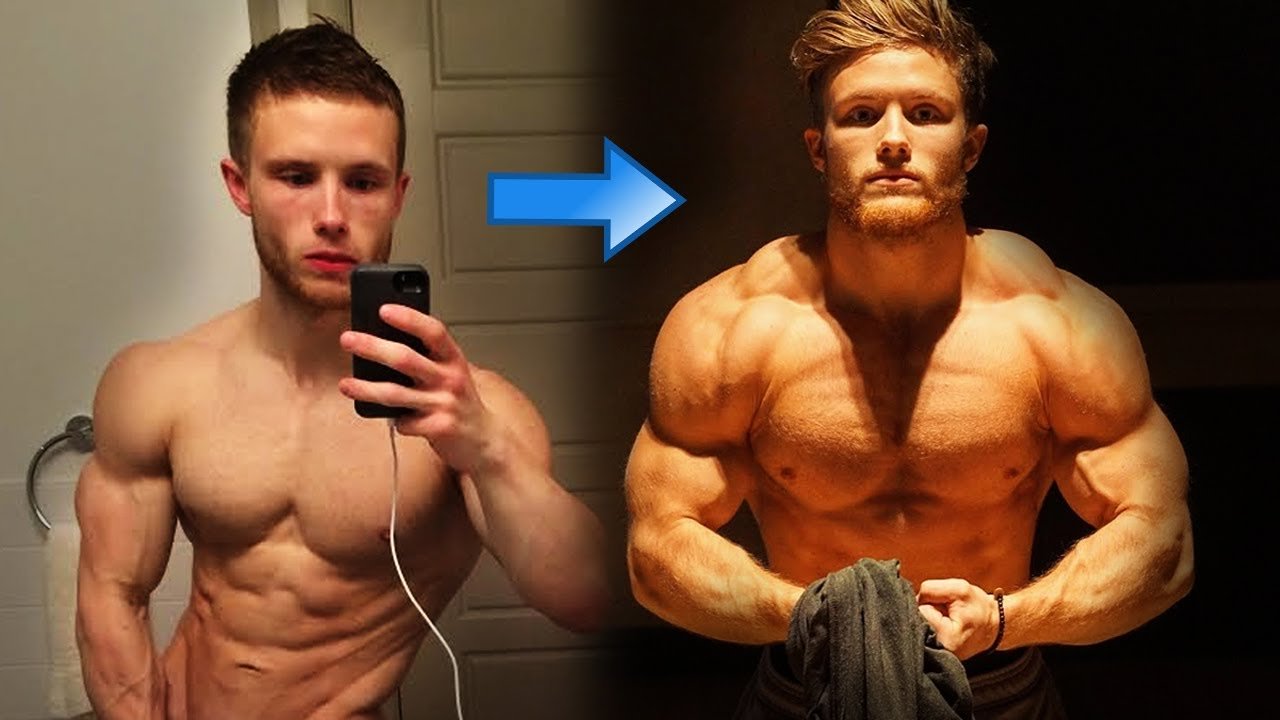To build a strong neck, a forehead attack is not suitable. A workaround is needed. The calling card of a truly strong person is a strong neck. It irrefutably testifies to the solid strength experience of its owner, since the neck muscles are directly involved only in the heaviest strength exercises: the clean and jerk of the barbell, clean-ups, deadlifts, shrugs and squats. In short, the owner of the bull’s rump did not do nonsense in the gym , like biceps curls, but did “correct” strength work. It’s your turn!
STRENGTH TEST
Modern science has confirmed what the athletes of the “golden era” of bodybuilding knew well. Only heavy multi-joint exercises, like squats, grow muscles. As for isolation exercises, when you bend only one joint, they are completely useless. As a last resort, they will help correct the external shape of the muscle.
The main training factor in bodybuilding, like any other strength sport, is the amount of working weight. (The bigger it is, the better!) However, only bodybuilding requires a huge training volume, i.e. an extremely large number of sets and repetitions performed per workout. It is for this reason that “useless” isolation exercises have come into use in our sport. Nobody can do several hundred squats with an extremely heavy barbell at once. So the “normative” repetitions are wisely divided between squats and other, “lighter” exercises, like isolating leg extensions in the machine.
Why don’t isolation movements “work”? Nature takes care of our joints and deliberately “cuts” the strength of a muscle when you bend only one joint with the force of this muscle. A critical load is permissible only when several joints are involved in the movement. Here is the irrefutable evidence of science. When performing heavy rows, which are accompanied by bending of the elbows, the power of contraction of the biceps increases by 30% compared to the known biceps curls.
The same rule applies to the neck muscles. You can’t pump up your neck with direct exercises! They can only be considered as auxiliary! To get a neck like an Olympia champion , we need classic strength exercises. They load the neck indirectly, but in specific terms this load is many times greater than that given by direct isolating exercises.
Yes, to get a bull neck, oddly enough, you will need standing presses, bench presses, deadlifts, dips, power cleans and squats to the point of a foul. Forward!
SPLIT:
Train 4 times a week. Let’s say Monday, Wednesday and Friday. Schedule the fourth workout for Monday of the next week, and start a new cycle on Wednesday. If you have a high level of fitness, then you should double your workouts. Train on Monday-Tuesday, and do the other two “paired” workouts at the end of the week, adjusting the rest interval according to how you feel.
TRAINING TIME:
45-60 min.
METHOD:
Exercises marked with the letters A and B are performed in the style of combined sets. Do a set of one exercise, rest, and then do a set of the second exercise. Do the remaining exercises of the complexes in accordance with the specified scheme of repetitions and sets.
WAVE PATTERN
1. Establish your one-time maximums on the following exercises: bench press, deadlift, bench press, squat and clean. Use 1RM formulas for 5-rep sets.
2. Subtract 10% from each of your records. As a result, you will receive an initial indicator for calculating working weights in each exercise. This indicator is called the “working maximum”. Let’s say your one-time maximum (1RM) for bench press is 110 kg. Then your “working maximum” (RM) for the bench press is 110 kg – 10% = 99 kg.
H. You will train in cycles of 4 weeks each. Each such cycle includes four microcycles equal to one week. In the first week you do 3 sets of 5 repetitions, in the second – 3 sets of 3 repetitions, in the third – 3 sets of 5 repetitions and in the last week of the cycle – again 3 sets of 5 repetitions. (See table WAVE DIAGRAM.)
4. The pre-established “working maximum” is used as the initial indicator for calculating the working weights in each exercise. In the first month, you change the working weights in each of the main exercises from week to week. (See table. WAVE SCHEME.)
5. The wave pattern is a uniquely fast way to gain mass and strength that does not require “failure.” Moreover, it strongly prohibits “refusals.” Training to the point of exhaustion unnecessarily weakens the nervous system, overstrains it, and it all ends with an inevitable disruption of hormonal secretion in strict accordance with the science of stress created by the great Hans Selye. When you finish a set, you may well throw in a couple of extra reps. But you don’t need to do this! The system is a proven scheme of force impact on the muscles, which confidently increases its potential due to the total impact of four weekly microcycles. All you have to do is follow the scientific scheme exactly. Before each main exercise, perform 2 warm-up sets, gradually increasing the load. Warm-up sets include 8-12 repetitions.
6. Having completed the first monthly cycle, you begin the second macrocycle for a period of 4 weeks. Here you will need to recalculate the previous “working maximums”. Add 2.5 kg to the RM of the standing press and bench press. Add 5 kg to the RM of deadlifts, squats and cleans. You will receive new “working maxima” against which you should calculate the working weights for basic exercises. (See table. WAVE SCHEME.) Having completed the second month of training, using a similar scheme, recalculate your RM for the third monthly macrocycle. Next, again add 2.5 kg to them in bench press exercises and 5 kg for deadlifts, squats and power cleans.
WAVE PATTERN
Week 1 Week 2 Week 3 Week 4
65% x 5 70% x3 75% x 5 40% X 5 75% x 5 80% x3
85% X 3 50% x 5
85% X 5 90% x3 95% X 1 60% x 5
DAY 1
1A. STANDING PRESS
SET: 3
REPS: Wave Pattern
Using a powerful, controlled force, press the barbell into straight arms. Without pausing at the top, return the barbell to your chest. Do a new repeat.
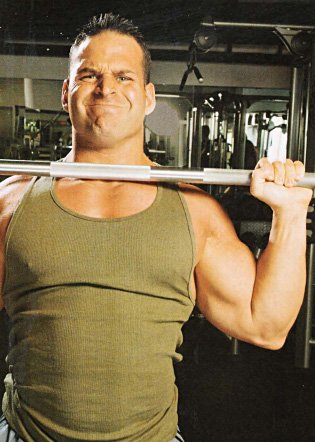
1B. PULL-UPS
SETS: 3
REPS: 5-10
Pull yourself up to the bar with a powerful effort. Return under control to the hanging position. If you don’t have enough strength for all the repetitions, pull yourself up from a support in a “rest-pause” style. Don’t let it get to the point of failure! Stop one rep before failure and stand on the support without taking your hands off the bar. Rest for 15 – 20 seconds. and do as many reps as you can. Bring the total number of pull-ups to the given number.
2A. DIPS PUSH-UPS
SETS: 5
REPS: 10
Assume a straight arms position on the parallel bars. Bend your elbows and lower yourself to the bottom position. Straighten your arms with a powerful effort and squeeze yourself to the starting position.
2B. T-Bar Row
SETS: 5
REPS: 10
Keeping your body at a 45-degree angle, raise your elbows as high as possible, thereby pulling the barbell up. At the top point of the lift, further squeeze your shoulder blades to the limit. Increase the weight of the barbell from set to set.
3. WEIGHTED NECK EXTENSION
SET: 3
REPS: 20
Attach a weight to a strength accessory called a head clamp. Take a sitting position and lean forward slightly. Fix the collar on your head with your palms and slowly tilt your head, bending your neck until your chin rests on your chest. Next, using a controlled effort, straighten your neck “in line” with your spine. Do not tilt your head too far back to prevent hyperextension of your neck.

DAY 2
1. DEADLIFT SET
: 3
REPS: Wave Pattern
Stand as close to the bar as possible, bend over and grab the bar with straight hands. Push your pelvis upward to lock your arms and bar into a strong “frame.” Keeping your back perfectly straight, slowly straighten up, starting the movement from your head.
ATTENTION! Do not use gymnastics straps. If you don’t have enough wrist strength for all the repetitions, use a different grip.
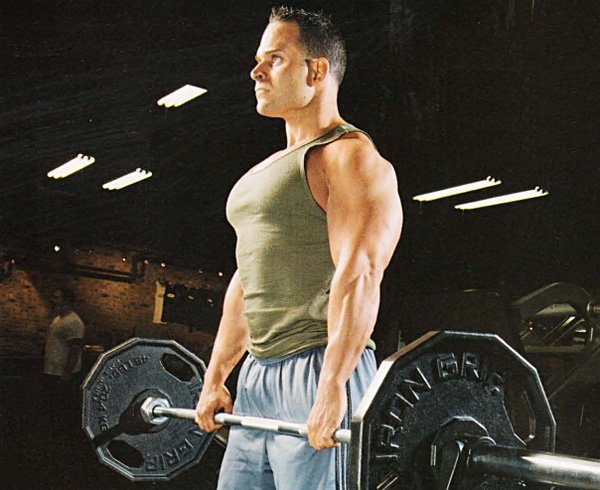
2. DUMBELL/KELL SWING
SET: 5
REPS: 20
Bend forward, move the weight back, and then straighten up powerfully and, with a full-body jerk, throw the kettlebell to shoulder height.

3. HANGING LEG RAISES
SET: 5
REPS: 10
With a powerful effort, lift your straight legs until they are parallel to the floor. Next, push your pelvis up and lift your straight legs up until they touch the bar.
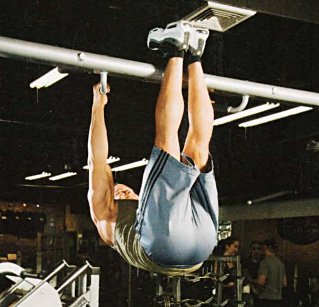
4. NECK BENDS
SETS: 3
REPS: 25
Take a lying position on the bench so that the edge of the bench rests on your shoulder blades and your head is suspended. Hold the barbell plate over your forehead with a towel underneath it. Bend your head down in a controlled manner, and then lift your head as high as possible with a powerful, controlled movement.
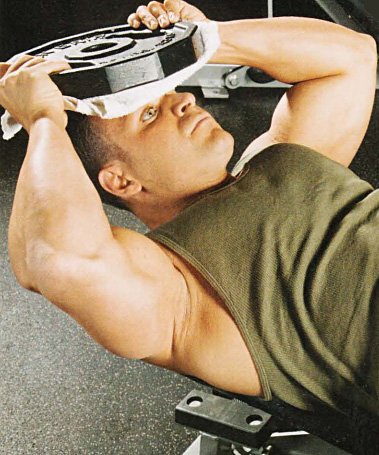
DAY 3
1A. BENCH PRESS
SETS: 3
REPS: Wave Pattern
Remove the barbell from the supports and lower it toward your chest without letting it touch. Press the barbell powerfully with your arms straight above your chest. Return the barbell to your chest under control. Do a new repeat.
1B. UPPER WIDE ROW
SETS: 3
REPS: 5-10
Place your knees firmly under the supports and grasp the beveled ends of the long handle of the upper pulley. Straighten your arms. Pull the handle toward your chest with a powerful force. Additionally, squeeze your shoulder blades.
2. INCLINED DUMBBELL PRESS
SET: 5
REPS: 10
Take a lying position on an incline bench. Hold dumbbells at your shoulders. Squeeze the dumbbells into straight arms.
3. BAR SHRUGS
SETS: 5
REPS: 10
Straighten up and remove the barbell from the supports. With a powerful effort, lift your shoulders strictly vertically upward. Lower your shoulders under control to the starting position.

4. LATERAL HEAD RAISES
SETS: 3
REPS: 30
Take a side-lying position on the bench, keeping your head suspended. On top of your head, hold the plate away from the barbell by placing a towel underneath it. Slowly lower your head as low as possible. With a controlled effort, lift your head up. After completing all the given repetitions, roll over to the other side.
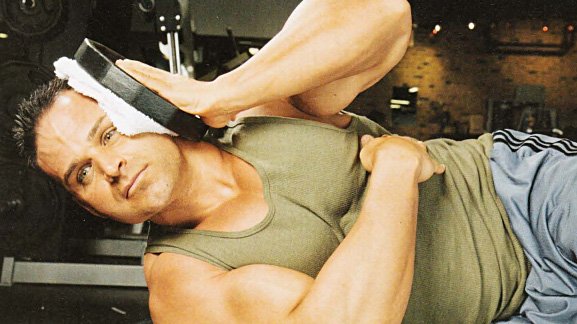
DAY 4
1. CHEST RAISES
SET: 3
REPS: Wave Pattern
Stand up straight, holding the barbell with your arms straight in front of your hips. Bend your knees slightly and throw the barbell onto your chest with a powerful explosive force. Bring your elbows forward. Return the barbell to your hips under control. The exercise is performed due to the total pushing movement of the whole body. If you’ve never done this exercise before, first practice it with an empty bar.

2. SQUATS
SETS: 3
REPS: wave pattern
Sit under the barbell mounted on the supports. Straighten up, taking the weight of the barbell onto your shoulders. Step back and balance your stance. Inhale powerfully and slowly lower yourself into a deep squat. Without pausing at the bottom, straighten up with a dynamic effort. When rising from a squat, keep your back perfectly straight.

3. LUNCHES
SET: 3
REPS: 6 (PER LEG)
Take heavy dumbbells in your hands. Step forward with one leg and lower yourself into a one-legged squat. Using an isolated effort, straighten your working leg and rise from the squat. Repeat with the other leg.
4. AB-ROLLER
REPS: 100 (TOTAL)
Holding a special ab-roller exercise machine (wheel with hand handles) in your straight hands, take the position of emphasis on the roller wheel.
Using an isolated press force, bend the waist and roll the roller towards you.
5. NECK CURL
SETS: 3
REPS: 25
Repeat the neck exercise you did on Day 2.
You can perform this movement with a head clamp. Don’t overdo the weight. Neck muscles are easy to stretch!

